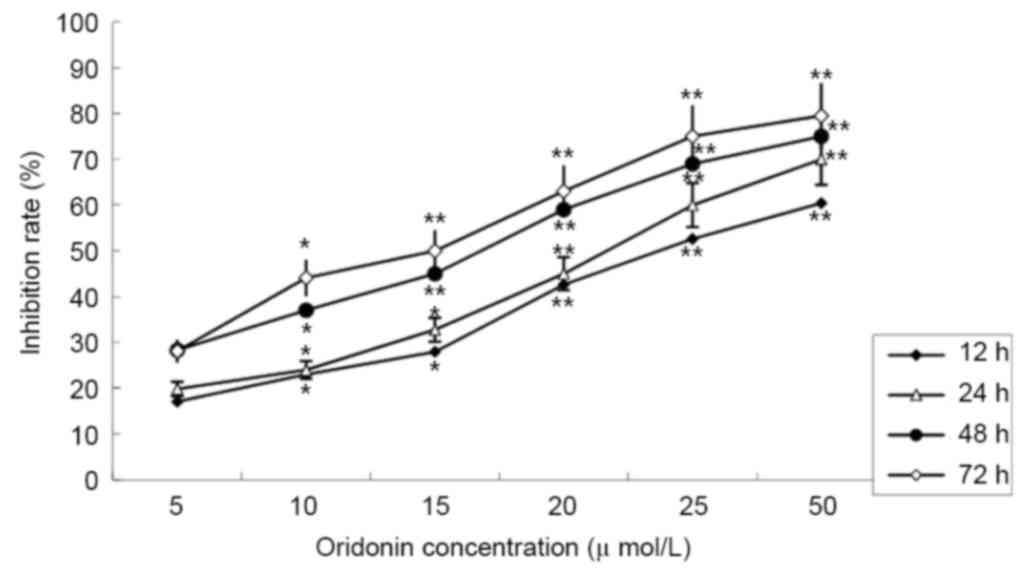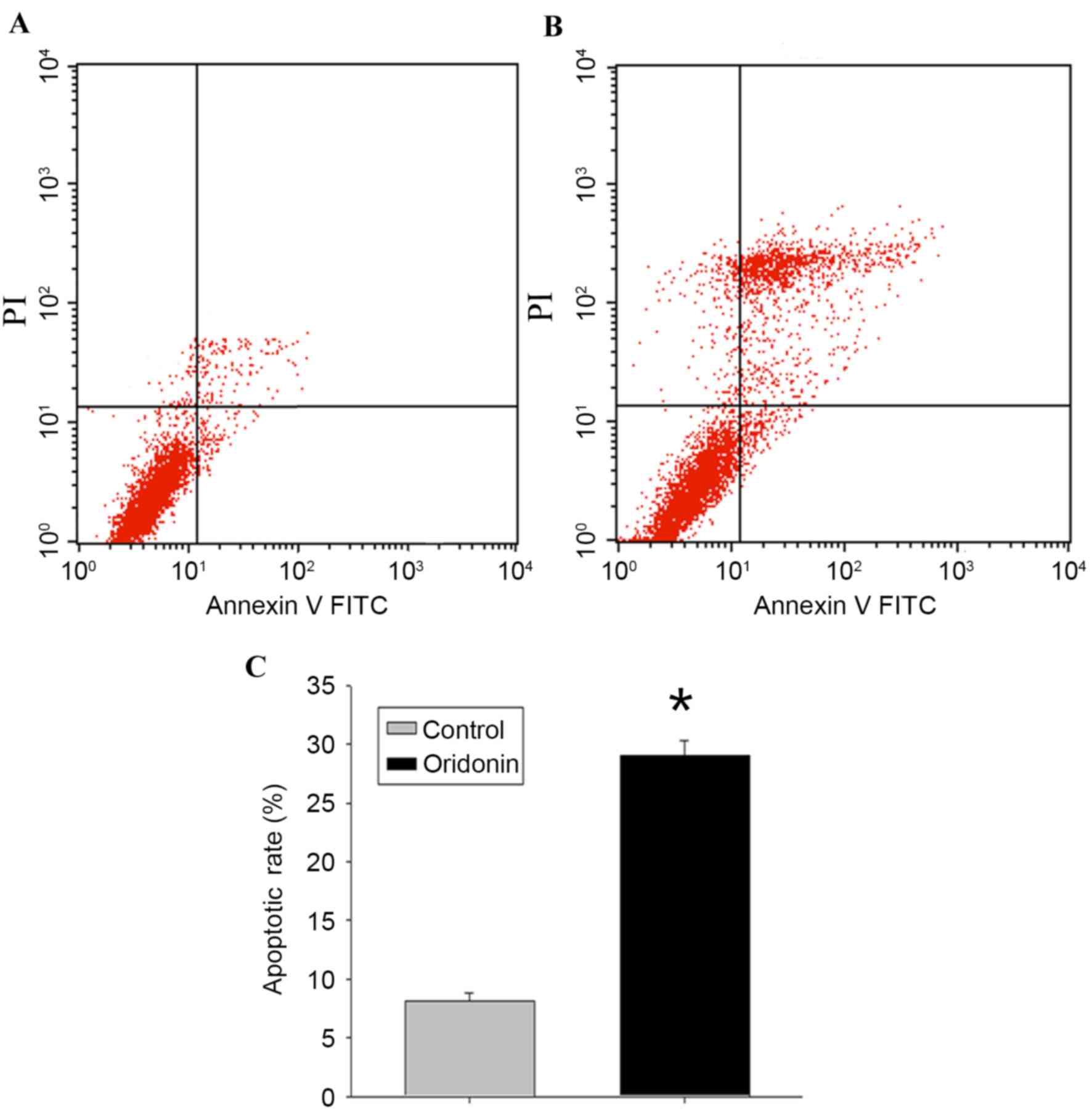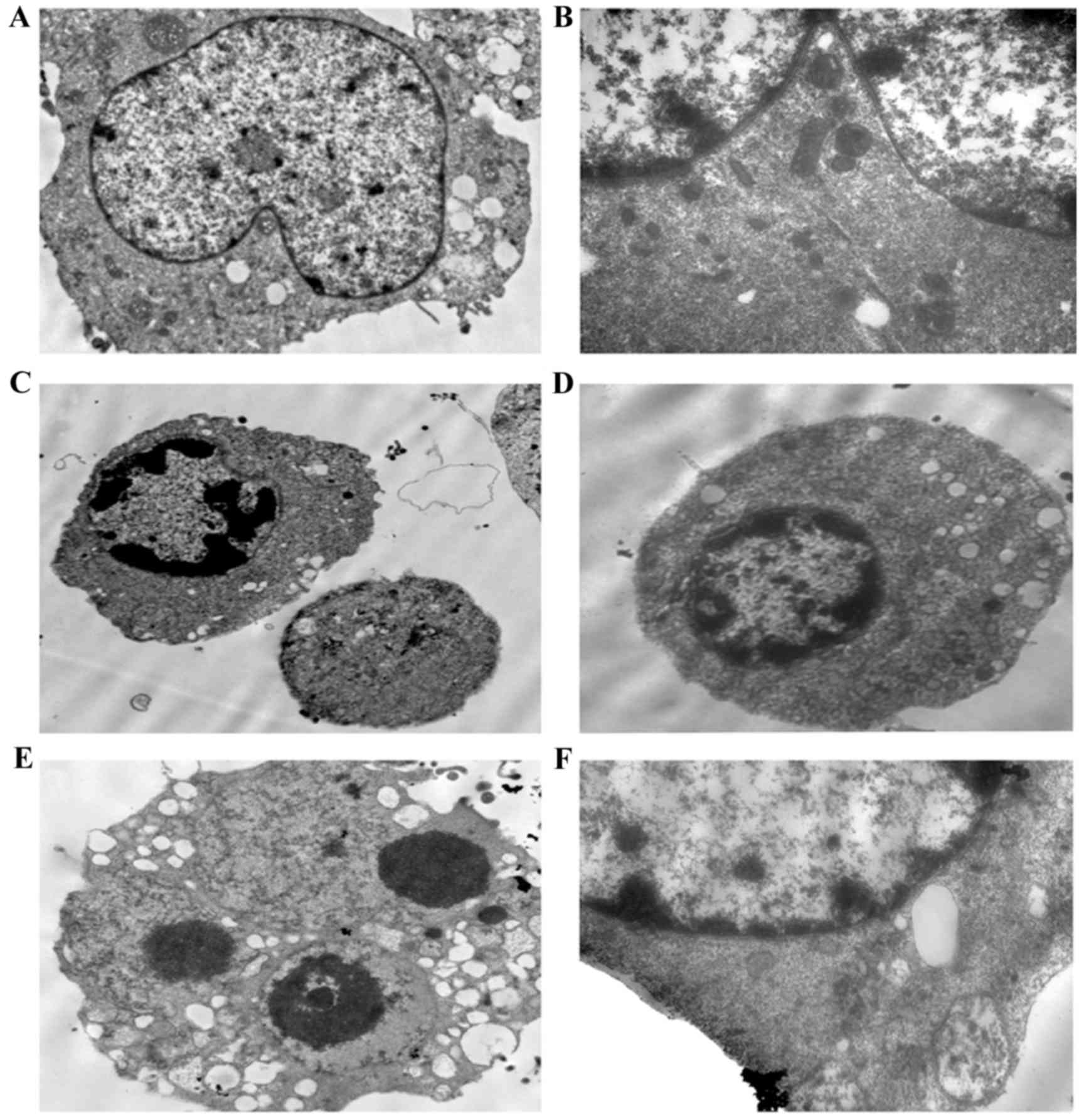|
1
|
Sirohi B and Powles R: Multiple myeloma.
Lancet. 363:875–887. 2004. View Article : Google Scholar : PubMed/NCBI
|
|
2
|
Mahindra A, Laubach J, Raje N, Munshi N,
Richardson PG and Anderson K: Latest advances and current
challenges in the treatment of multiple myeloma. Nat Rev Clin
Oncol. 9:135–143. 2012. View Article : Google Scholar : PubMed/NCBI
|
|
3
|
Cheng Y, Qiu F, Ye YC, Tashiro S, Onodera
S and Ikejima T: Oridonin induces G2/M arrest and apoptosis via
activating ERK-p53 apoptotic pathway and inhibiting PTK-Ras-Raf-JNK
survival pathway in murine fibrosarcoma L929 cells. Arch Biochem
Biophys. 490:70–75. 2009. View Article : Google Scholar : PubMed/NCBI
|
|
4
|
Yang J, Jiang H, Wang C, Yang B, Zhao L,
Hu D, Qiu G, Dong X and Xiao B: Oridonin triggers apoptosis in
colorectal carcinoma cells and suppression of microRNA-32
expression augments oridonin-mediated apoptotic effects. Biomed
Pharmacother. 72:125–134. 2015. View Article : Google Scholar : PubMed/NCBI
|
|
5
|
Kang N, Zhang JH, Qiu F, Tashiro S,
Onodera S and Ikejima T: Inhibition of EGFR signaling augments
oridonin-induced apoptosis in human laryngeal cancer cells via
enhancing oxidative stress coincident with activation of both the
intrinsic and extrinsic apoptotic pathways. Cancer Lett.
294:147–158. 2010. View Article : Google Scholar : PubMed/NCBI
|
|
6
|
Lou H, Zhang X, Gao L, Feng F, Wang J, Wei
X, Yu Z, Zhang D and Zhang Q: In vitro and in vivo antitumor
activity of oridonin nanosuspension. Int J Pharm. 379:181–186.
2009. View Article : Google Scholar : PubMed/NCBI
|
|
7
|
Liu YQ, Mu ZQ, You S, Tashiro S, Onodera S
and Ikejima T: Fas/FasL Signaling allows extracelluar-signal
regulated kinase to regulate cytochrome c release in
oridonin-induced apoptotic u937 cells. Biol Pharm Bull.
29:1873–1879. 2006. View Article : Google Scholar : PubMed/NCBI
|
|
8
|
Ren KK, Wang HZ, Xie LP, Chen DW, Liu X,
Sun J, Nie YC and Zhang RQ: The effects of oridonin on cell growth,
cell cycle, cell migration and differentiation in melanoma cells. J
Ethnopharmacol. 103:176–180. 2006. View Article : Google Scholar : PubMed/NCBI
|
|
9
|
Zhang Y, Wu Y, Tashiro S, Onodera S and
Ikejima T: Involvement of PKC signal pathways in oridonin-induced
autophagy in HeLa cells: A protective mechanism against apoptosis.
Biochem Biophys Res Commun. 378:273–278. 2009. View Article : Google Scholar : PubMed/NCBI
|
|
10
|
Hsieh TC, Wijeratne EK, Liang JY,
Gunatilaka AL and Wu JM: Differential control of growth, cell cycle
progression and expression of NF-kappaB in human breast cancer
cells MCF-7, MCF-10A, and MDA-MB-231 by ponicidin and oridonin,
diterpenoids from the chinese herb Rabdosia rubescens. Biochem
Biophys Res Commun. 337:224–231. 2005. View Article : Google Scholar : PubMed/NCBI
|
|
11
|
Hanash SM, Madoz-Gurpide J and Misek DE:
Identification of novel targets for cancer therapy using expression
proteomics. Leukemia. 16:478–485. 2002. View Article : Google Scholar : PubMed/NCBI
|
|
12
|
Ramagli L: Quantifying protein in 2-D PAGE
solubilization buffers2-D Proteome Analysis Protocols. Link AJ:
112. Humana Press; Totowa, NJ: pp. 99–103. 1999, View Article : Google Scholar
|
|
13
|
Görg A, Postel W and Günther S: The
current state of two-dimensional electrophoresis with immobilized
pH gradients. Electrophoresis. 9:531–546. 1988. View Article : Google Scholar : PubMed/NCBI
|
|
14
|
B Tom ST: 2-D electrophoresis using
immobilized pH gradients, pricinples and methods. Amersham
Pharmacia Biotech. 1998.
|
|
15
|
Pasquali C, Fialka I and Huber LA:
Preparative two-dimensional gel electrophoresis of membrane
proteins. Electrophosis. 18:2573–2781. 1997. View Article : Google Scholar
|
|
16
|
Iversen LF, Kastrup JS, Bjørn SE, Wiberg
FC, Larsen IK, Flodgaard HJ and Rasmussen PB: Structure and
function of the N-linked glycans of HBP/CAP37/azurocidin: Crystal
structure determination and biological characterization of
nonglycosylated HBP. Protein Sci. 8:2019–2026. 1999. View Article : Google Scholar : PubMed/NCBI
|
|
17
|
Livak KJ and Schmittgen TD: Analysis of
relative gene expression data using real-time quantitative PCR and
the 2(−Delta Delta C(T)) Method. Methods. 25:402–408. 2001.
View Article : Google Scholar : PubMed/NCBI
|
|
18
|
Zhu Y, Xie L, Chen G, Chen G, Wang H and
Zhang R: Effects of oridonin on proliferation of HT29 human colon
carcinoma cell lines both in vitro and in vivo in mice. Pharmazie.
62:439–444. 2007.PubMed/NCBI
|
|
19
|
Dal Piaz F, Cotugno R, Lepore L, Vassallo
A, Malafronte N, Lauro G, Bifulco G, Belisario MA and De Tommasi N:
Chemical proteomics reveals HSP70 1A as a target for the anticancer
diterpene oridonin in Jurkat cells. J Proteomics. 82:14–26. 2013.
View Article : Google Scholar : PubMed/NCBI
|
|
20
|
Charbaut E, Curmi PA, Ozon S, Lachkar S,
Redeker V and Sobel A: Stathmin family proteins display specific
molecular and tubulin binding properties. J Biol Chem.
276:16146–16154. 2001. View Article : Google Scholar : PubMed/NCBI
|
|
21
|
Alli E, Yang JM and Hait WN: Silencing of
stathmin induces tumor-suppressor function in breast cancer cell
lines harboring mutant p53. Oncogene. 26:1003–1012. 2007.
View Article : Google Scholar : PubMed/NCBI
|
|
22
|
Mistry SJ, Bank A and Atweh GF: Targeting
stathmin in prostate cancer. Mol Cancer Ther. 4:1821–1829. 2005.
View Article : Google Scholar : PubMed/NCBI
|
|
23
|
Mistry SJ and Atweh GF: Therapeutic
interactions between stathmin inhibition and chemotherapeutic
agents in prostate cancer. Mol Cancer Ther. 5:3248–3257. 2006.
View Article : Google Scholar : PubMed/NCBI
|
|
24
|
Yuan RH, Jeng YM, Chen HL, Lai PL, Pan HW,
Hsieh FJ, Lin CY, Lee PH and Hsu HC: Stathmin overexpression
cooperates with p53 mutation and osteopontin overexpression, and is
associated with tumour progression, early recurrence, and poor
prognosis in hepatocellular carcinoma. J Pathol. 209:549–558. 2006.
View Article : Google Scholar : PubMed/NCBI
|
|
25
|
Zhang HZ, Wang Y, Gao P, Lin F, Liu L, Yu
B, Ren JH, Zhao H and Wang R: Silencing stathmin gene expression by
survivin promoter-driven siRNA vector to reverse malignant
phenotype of tumor cells. Cancer Biol Ther. 5:1457–1461. 2006.
View Article : Google Scholar : PubMed/NCBI
|
|
26
|
Iancu C, Mistry SJ, Arkin S and Atweh GF:
Taxol and anti-stathmin therapy: A synergistic combination that
targets the mitotic spindle. Cancer Res. 60:3537–3541.
2000.PubMed/NCBI
|
|
27
|
Jensen DE, Black AR, Swick AG and Azizkhan
JC: Distinct roles for Sp1 and E2F sites in the growth/cell cycle
regulation of the DHFR promoter. J Cell Biochem. 67:24–31. 1997.
View Article : Google Scholar : PubMed/NCBI
|
|
28
|
Chen MJ, Shimada T, Moulton AD, Cline A,
Humphries RK, Maizel J and Nienhuis AW: The functional human
dihydrofolate reductase gene. J Biol Chem. 259:3933–3943.
1984.PubMed/NCBI
|
|
29
|
Assaraf YG: Molecular basis of antifolate
resistance. Cancer Metastasis Rev. 26:153–181. 2007. View Article : Google Scholar : PubMed/NCBI
|
|
30
|
Morales C, García MJ, Ribas M, Miró R,
Muñoz M, Caldas C and Peinado MA: Dihydrofolate reductase
amplification and sensitization to methotrexate of
methotrexate-resistant colon cancer cells. Mol Cancer Ther.
8:424–432. 2009. View Article : Google Scholar : PubMed/NCBI
|
|
31
|
Biaglow JE and Miller RA: The thioredoxin
reductase/thioredoxin system: Novel redox targets for cancer
therapy. Cancer Biol Ther. 4:6–13. 2005. View Article : Google Scholar : PubMed/NCBI
|
|
32
|
Nguyen P, Awwad RT, Smart DD, Spitz DR and
Gius D: Thioredoxin reductase as a novel molecular target for
cancer therapy. Cancer Lett. 236:164–174. 2006. View Article : Google Scholar : PubMed/NCBI
|
|
33
|
Yoo MH, Xu XM, Carlson BA, Gladyshev VN
and Hatfield DL: Thioredoxin reductase 1 deficiency reverses tumor
phenotype and tumorigenicity of lung carcinoma cells. J Biol Chem.
281:13005–13008. 2006. View Article : Google Scholar : PubMed/NCBI
|
|
34
|
Lu J, Chew EH and Holmgren A: Targeting
thioredoxin reductase is a basis for cancer therapy by arsenic
trioxide. Proc Natl Acad Sci USA. 104:12288–12293. 2007. View Article : Google Scholar : PubMed/NCBI
|
|
35
|
Wang X, Zhang J and Xu T: Cyclophosphamide
as a potent inhibitor of tumor thioredoxin reductase in vivo.
Toxicol Appl Pharmacol. 218:88–95. 2007. View Article : Google Scholar : PubMed/NCBI
|
|
36
|
Glushakova LG, Lisankie MJ, Eruslanov EB,
Ojano-Dirain C, Zolotukhin I, Liu C, Srivastava A and Stacpoole PW:
AAV3-mediated transfer and expression of the pyruvate dehydrogenase
E1 alpha subunit gene causes metabolic remodeling and apoptosis of
human liver cancer cells. Mol Genet Metab. 98:289–299. 2009.
View Article : Google Scholar : PubMed/NCBI
|
|
37
|
Lu J, Tan M and Cai Q: The Warburg effect
in tumor progression: Mitochondrial oxidative metabolism as an
anti-metastasis mechanism. Cancer Lett. 356:156–164. 2015.
View Article : Google Scholar : PubMed/NCBI
|
|
38
|
Michelakis ED, Webster L and Mackey JR:
Dichloroacetate (DCA) as a potential metabolic-targeting therapy
for cancer. Br J Cancer. 99:989–994. 2008. View Article : Google Scholar : PubMed/NCBI
|














